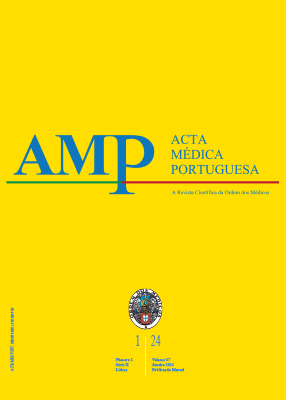Actinomycetoma by Cellulosimicrobium cellulans in a Young Man from Guinea-Bissau: Short Literature Review Regarding a Case Report
DOI:
https://doi.org/10.20344/amp.17356Keywords:
Actinomycetales, Mycetoma/diagnosis, Mycetoma/therapyAbstract
Mycetoma is caused by the subcutaneous inoculation of filamentous fungi or aerobic filamentous bacteria. Cellulosimicrobium cellulans is a gram-positive bacterium from the order Actinomycetales that rarely causes human disease. The diagnosis is based on the clinical presentation and identification of the causative microorganism. We present a short literature review regarding the case report of a young man diagnosed with actinomycetoma due to Cellulosimicrobium cellulans and who received treatment with an association of amikacin and sulfamethoxazole/ trimethoprim (Welsh regimen).
Downloads
References
Emery D, Denning DW. The global distribution of actinomycetoma and eumycetoma. PLoS Negl Trop Dis. 2020;14:1-13. DOI: https://doi.org/10.1371/journal.pntd.0008397
Zijlstra EE, van de Sande WW, Welsh O, Mahgoub ES, Goodfellow M, Fahal AH. Mycetoma: a unique neglected tropical disease. Lancet Infect Dis. 2016;16:100-12. DOI: https://doi.org/10.1016/S1473-3099(15)00359-X
van de Sande WW. Global burden of human mycetoma: a systematic review and meta-analysis. PLoS Negl Trop Dis. 2013;7:1-11. DOI: https://doi.org/10.1371/journal.pntd.0002550
Emmanuel P, Dumre SP, John S, Karbwang J, Hirayama K. Mycetoma: a clinical dilemma in resource limited settings. Ann Clin Microbiol Antimicrob. 2018;17:1-10. DOI: https://doi.org/10.1186/s12941-018-0287-4
Fatahi-bafghi M. Nocardiosis from 1888 to 2017. Microb Pathog. 2017;114:169-84. DOI: https://doi.org/10.1016/j.micpath.2017.11.012
Rivero M, Alonso J, Ramón MF, Gonzalez N, Pozo A, Marín I, et al. Infections due to cellulosimicrobium species: case report and literature review. BMC Infect Dis. 2019;19:1-9. DOI: https://doi.org/10.1186/s12879-019-4440-2
Duane RH. Agents of mycetoma. In: Bennett JE, Dolin R, Blaser MJ, editors. Mandell, Douglas and Bennett’s principles and practice of infectious diseases. 9th ed. Philadelphia: Elsevier; 2020. p.3141-5.e1.
Ramachandra BV, Nayar AS, Subhashini, Chennamsetty K. Mycetoma caused by madurella mycetomatis. Lancet Infect Dis. 2013;2:305. DOI: https://doi.org/10.4103/2277-8632.122183
World Health Organization. Results of the 2017 global WHO survey on yaws. Wkly Epidemiol Rec. 2017;93:417-22.
Fahal A, Mahgoub ES, Mohamed A, Abdel-Rahman ME, Alshambaty Y, Hashim A, et al. A new model for management of mycetoma in the Sudan. PLoS Negl Trop Dis. 2014;8:1-12. DOI: https://doi.org/10.1371/journal.pntd.0003271
Welsh O, Vera-Cabrera L, Welsh E, Salinas MC. Actinomycetoma and advances in its treatment. Clin Dermatol. 2012;30:372-81. DOI: https://doi.org/10.1016/j.clindermatol.2011.06.027
Arenas R, Fernandez Martinez RF, Torres-Guerrero E, Garcia C. Actinomycetoma: an update on diagnosis and treatment. Cutis. 2017;99:E11-5.
Garza JA, Welsh O, Cuéllar-Barboza A, Suarez-Sánchez K, de la Cruz-Valadez E, Cruz-Gomez L, et al. Clinical characteristics and treatment of actinomycetoma in northeast Mexico: a case series. PLoS Negl Trop Dis. 2020;14:1-14. DOI: https://doi.org/10.1371/journal.pntd.0008123
Hay RJ. Subcutaneous mycoses: general principles. In: Ryan ET, Hill DR, Solomon T, Aronson NE, Endy TP, editors. Hunter’s Tropical Medicine and emerging infectious disease. 10th ed. Philadelphia: Elsevier; 2020. p.653-8.
Salim AO, Mwita CC, Gwer S. Treatment of madura foot: a systematic review. JBI Database Syst Rev Implement Rep. 2018;16:1519-36. DOI: https://doi.org/10.11124/JBISRIR-2017-003433
Agarwal P, Jagati A, Rathod SP, Kalra K, Patel S, Chaudhari M. Clinical features of mycetoma and the appropriate treatment options. Res Rep Trop Med. 2021;12:173-9. DOI: https://doi.org/10.2147/RRTM.S282266
Verma P, Jha A. Mycetoma: reviewing a neglected disease. Clin Exp Dermatol. 2019;44:123-9. DOI: https://doi.org/10.1111/ced.13642
Shamy ME, Fahal AH, Shakir MY, Homeida MM. New MRI grading system for the diagnosis and management of mycetoma. Trans R Soc Trop Med Hyg. 2012;106:738-42. DOI: https://doi.org/10.1016/j.trstmh.2012.08.009
Laohawiriyakamol T, Tanutit P, Kanjanapradit K, Hongsakul K, Ehara S. The “dot-in-circle” sign in musculoskeletal mycetoma on magnetic resonance imaging and ultrasonography. Springerplus. 2014;3:1-7. DOI: https://doi.org/10.1186/2193-1801-3-671
Fahal AH. Evidence-based guidelines for the management of mycetoma patients. Mycetoma Research Center. Khartoum: University of Khartoum; 2002.
Downloads
Published
How to Cite
Issue
Section
License
Copyright (c) 2023 Acta Médica Portuguesa

This work is licensed under a Creative Commons Attribution-NonCommercial 4.0 International License.
All the articles published in the AMP are open access and comply with the requirements of funding agencies or academic institutions. The AMP is governed by the terms of the Creative Commons ‘Attribution – Non-Commercial Use - (CC-BY-NC)’ license, regarding the use by third parties.
It is the author’s responsibility to obtain approval for the reproduction of figures, tables, etc. from other publications.
Upon acceptance of an article for publication, the authors will be asked to complete the ICMJE “Copyright Liability and Copyright Sharing Statement “(http://www.actamedicaportuguesa.com/info/AMP-NormasPublicacao.pdf) and the “Declaration of Potential Conflicts of Interest” (http:// www.icmje.org/conflicts-of-interest). An e-mail will be sent to the corresponding author to acknowledge receipt of the manuscript.
After publication, the authors are authorised to make their articles available in repositories of their institutions of origin, as long as they always mention where they were published and according to the Creative Commons license.









